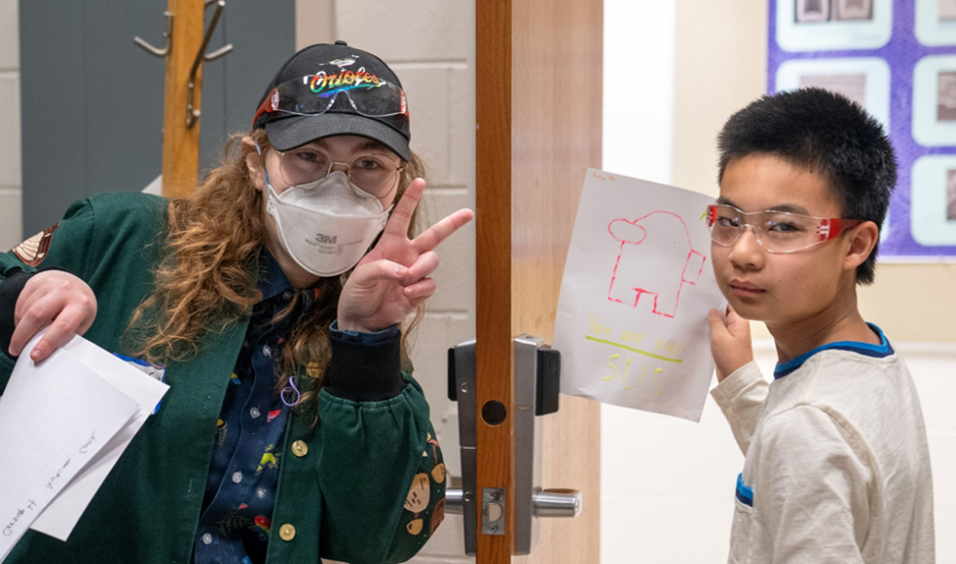Inspiring the Next Generation: Tour of the Illinois’ Materials Research Laboratory

By Bruce Adams, Contributing Writer
May 1, 2024
"I love doing outreach and showing students cool things about the world. The reason why I got into science was because I wanted to understand why cool things happened, and now here I am, getting a PhD."
These words from Autumn Cook, a third-year Ph.D. student in chemistry, encapsulate the essence of an excursion by middle school students from Franklin STEAM Academy in Champaign to the Materials Research Lab (MRL) at the University of Illinois Urbana-Champaign on Friday, February 9.
The tour builds upon a collaboration between I-MRSEC, funded by the National Science Foundation (NSF), aimed at fostering middle school students' interest in science, engineering, and mathematics through direct engagement with Illinois faculty, graduate, and post-doctoral students. The initiative particularly targets students from marginalized and previously excluded populations who often lose interest in STEM fields after middle school.

At left, Autumn Cook and a middle school participant show off their creation from the fluorescence activity. (Photo by Heather Coit).
For Cook, the decision to participate in this outreach initiative was driven by a personal mission to serve as a role model for queer and trans individuals in science—a representation they wished they had during their own academic journey.
"I was approached by Pamela A Pena Martin because my PI, Alexa Kuenstler, is part of the I-MRSEC grant. I love doing this type of work because when I was in graduate school and, to a certain extent, college, I didn't have any queer and trans role models in science during my graduate school and college years. I want to be that role model for the next generation of scientists or at least show them that queer adults exist and are thriving," Cook expressed. Hence, volunteering as a tour guide and group leader for middle schoolers was an instinctive choice for them.
During the tour, alongside other student guides and MRL research scientists, I-MRSEC staff presented a myriad of fascinating demonstrations to the Franklin students. Kathy Walsh showcased the capabilities of a 3D Optical Profiler by examining the surfaces of candies like Skittles, Sweethearts, and Nerds up close—a visual feast for curious minds.

Dr. Kathy Walsh, second from right, and a group of middle schoolers at the 3D Optical Profilometer, show off the candy samples they studied. (Photo by Heather Coit).
Xiaoli Wang led a Cleanroom tour, providing insights into research conducted on ultra-sensitive materials, where even a speck of dust could disrupt an experiment.


Roddel Remy engaged the students with a demonstration on testing the crunchiness of snack foods, using pretzels and potato straws as examples.
Michael Smith, from the Illinois Quantum Information Science and Technology Center (IQUIST), delved into the realm of quantum science, demonstrating how manipulating frequencies can affect wire circles and metal strips—a captivating glimpse into the future of technology.
Julio Soares illuminated the Fluorescence Room, unraveling the mysteries of light waves and colors with a homemade spectrometer, allowing Franklin students to explore the fluorescent properties of their drawings with magic markers and a blacklight.
Beyond the excitement of witnessing these awe-inspiring demonstrations and enjoying pizza for lunch, the field trip provided Franklin students with a energetic opportunity to witness a diverse group of researchers in action.
Their dedication to outreach exemplifies the transformative power of mentorship and representation in STEM. As they continue to inspire and empower the next generation of scientists, let us remember the importance of inclusivity and diversity in shaping the future of scientific innovation. Through such experiences, the students can envision themselves as future contributors to the world of science.
 At right, Dr. Julio Soares helps a middle schooler view light through a spectrometer that separates light into its components. (Photo by Pamela Pena Martin).
At right, Dr. Julio Soares helps a middle schooler view light through a spectrometer that separates light into its components. (Photo by Pamela Pena Martin).












.jpg)
















